 In March of 2006, a very unusual West Virginia quarter was discovered by Gregory Capps, a member of my on-line group, the Error Coin Information Exchange (https://groups.yahoo.com/group/errorcoininformationexchange/). It shows a faint, curved groove on the obverse and the motto E PLURIBUS UNUM on the reverse. Both features lie directly opposite each other in vertical space. Above the motto you can just make out the top of the date (2005) and the exergue above that.
In March of 2006, a very unusual West Virginia quarter was discovered by Gregory Capps, a member of my on-line group, the Error Coin Information Exchange (https://groups.yahoo.com/group/errorcoininformationexchange/). It shows a faint, curved groove on the obverse and the motto E PLURIBUS UNUM on the reverse. Both features lie directly opposite each other in vertical space. Above the motto you can just make out the top of the date (2005) and the exergue above that.
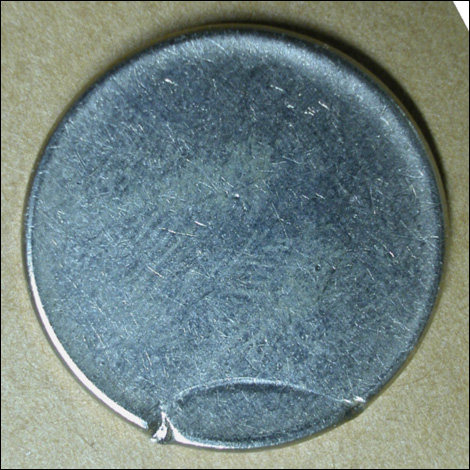
Shallow groove on the obverse of a 2005 West Virginia quarter with an “invisible strike”. This strike-through error is probably from a machine part or piece of hardware. Coin discovered by Gregory Capps.
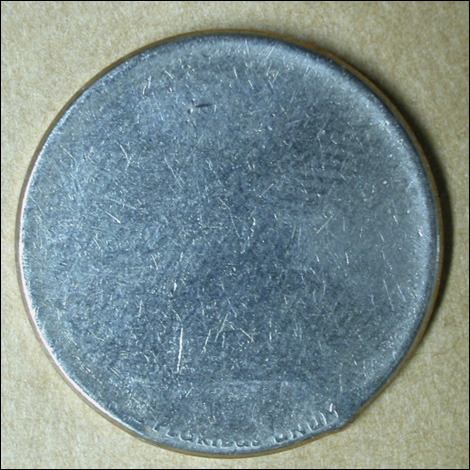
Faint die-struck design elements on the reverse include E PLURIBUS UNUM, the top of the date, and the exergue above the date.
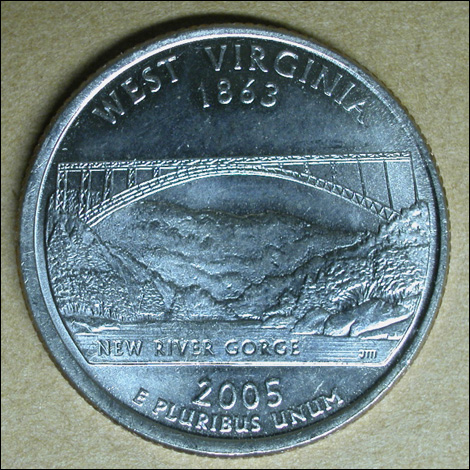
Reverse of a normal West Virginia quarter, shown for comparison purposes.
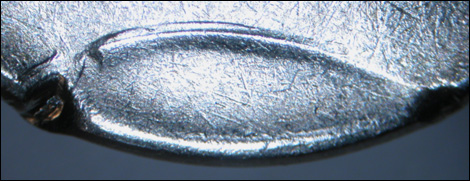
Close-up of the groove and the two angular indentations at each end.
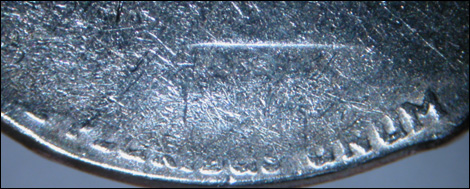
Close-up of the motto and associated design elements. They are located directly across from the groove in vertical space.
The coin displays a very rare error type that I’ve designated an “invisible strike”. An invisible strike occurs when the dies are out of adjustment, or are prevented from approximating normally, so at their closest approach they are farther apart than the thickness of a planchet. Normally in this situation the planchet is ejected from the striking chamber without showing any sign of having passed through it. However, if something intrudes into the striking chamber it will take up the excess space between the dies, permitting one of the dies to strike the opposite face (Diamond, 2000, 2003a, 2003b).
In this case, a machine part or a piece of hardware intruded into the striking chamber, leaving a thin curved arch on the obverse surface of the planchet. It does not appear to represent an impression of the proto-rim of an unstruck planchet. The arch is slightly lopsided and at each end there is a deep, angular indentation.
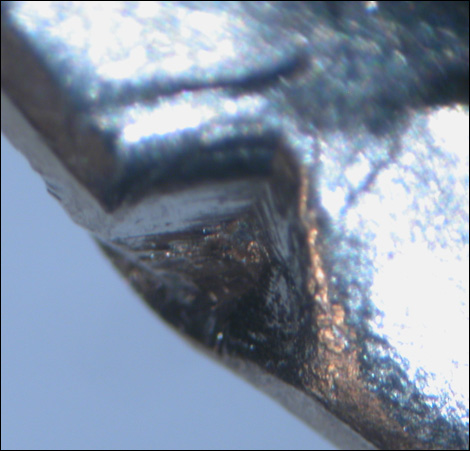
Close-up view of the left angular indentation.
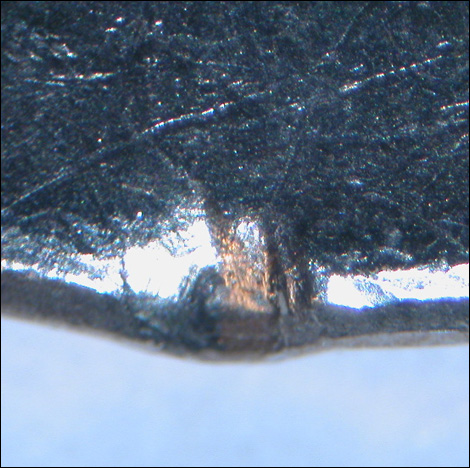
Close-up view of the right angular indentation.
It appears that the coin was struck out-of-collar as well. The deeper of the two angular indentations forced out a small bulge in the planchet’s edge. I suspect that, if the collar had been deployed, I would have detected at least a trace of reeding at the apex of the bulge. But the edge is smooth throughout.
The West Virginia quarter is by no means unique. The images below show a very similar error on a nickel. The reverse shows an island of design (part of Monticello) while, directly across from it on the opposite face, there is a shallow, roughly circular depression. I’m not sure what caused this strike-through error, but this intrusive object took up the excess space between the dies, permitting a weak but recognizable strike to form on the opposite face.
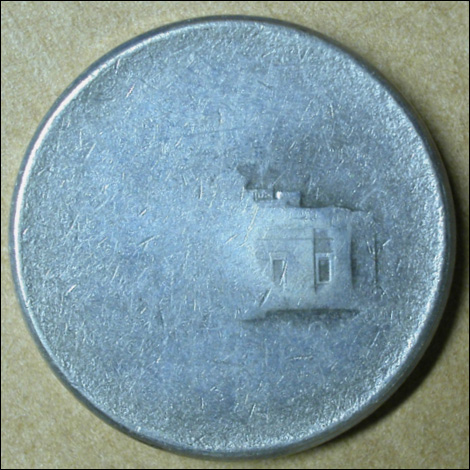
Reverse of an invisible strike nickel showing an isolated region of Monticello. Coin acquired from Rich Schemmer.
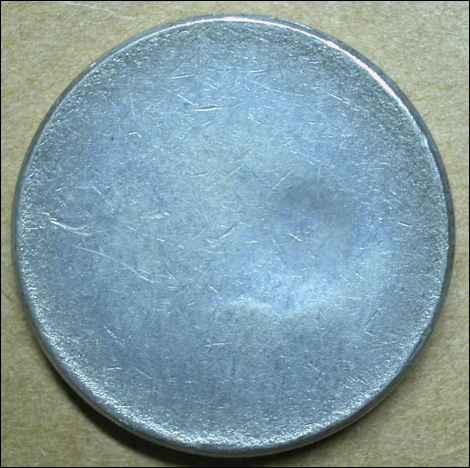
The obverse shows a shallow, circular strike-through error. It lies opposite the island of die-struck design on the reverse.
Invisible strikes that occur in conjunction with strike-through errors are less frequently encountered than those that co-occur with indents and partial brockages. Figure 6 shows a more “conventional” invisible strike in a nickel. This nickel was struck about 30% off-center, but more than half of that strike is invisible. The reason we have any design at all is that a nickel planchet intruded between the obverse die and the planchet represented by this coin. The intrusive planchet took up the excess space between the dies, leaving an indent on the obverse and permitting a clear strike on the reverse directly across from the indent.
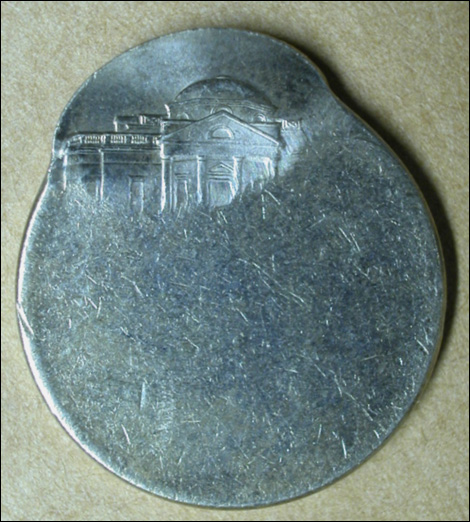
Reverse of an invisible strike nickel that was struck 30% off-center but which shows only the outer portion of the strike. Coin acquired from Paul Burrell.
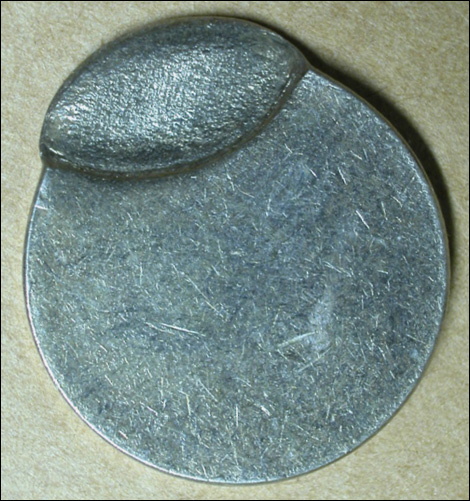
The obverse shows an indent from an unstruck planchet.
Invisible strikes are the ultimate quarry for the collector of weak strikes. Had it not been for a lucky accident, each one would have been indistinguishable from an unstruck planchet.
References
Diamond, Mike (2000) Weak strikes and “die trials”: Proximate and ultimate causes. Errorscope, Sept/Oct, pp. 18-21
Diamond, Mike (2003a) Invisible strikes: A closer look. Errorscope, March/April pp. 7 – 14
Diamond, Mike (2003b) Further insights on press function from an “invisible strike” nickel. Errorscope, Nov/Dec, p.16

